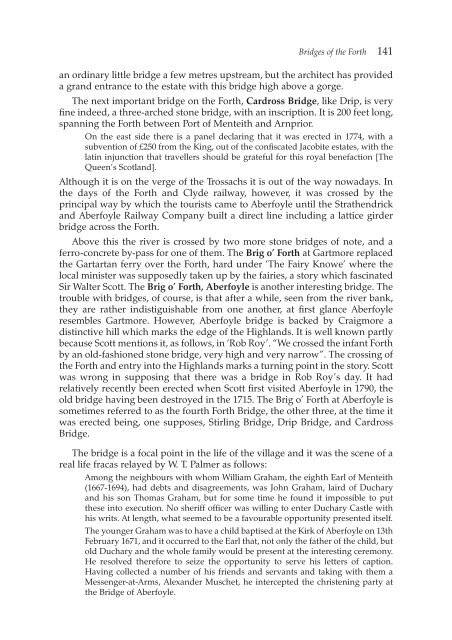the Forth Naturalist Historian - Forth Naturalist and Historian ...
the Forth Naturalist Historian - Forth Naturalist and Historian ...
the Forth Naturalist Historian - Forth Naturalist and Historian ...
You also want an ePaper? Increase the reach of your titles
YUMPU automatically turns print PDFs into web optimized ePapers that Google loves.
Bridges of <strong>the</strong> <strong>Forth</strong> 141<br />
an ordinary little bridge a few metres upstream, but <strong>the</strong> architect has provided<br />
a gr<strong>and</strong> entrance to <strong>the</strong> estate with this bridge high above a gorge.<br />
The next important bridge on <strong>the</strong> <strong>Forth</strong>, Cardross Bridge, like Drip, is very<br />
fine indeed, a three-arched stone bridge, with an inscription. It is 200 feet long,<br />
spanning <strong>the</strong> <strong>Forth</strong> between Port of Menteith <strong>and</strong> Arnprior.<br />
On <strong>the</strong> east side <strong>the</strong>re is a panel declaring that it was erected in 1774, with a<br />
subvention of £250 from <strong>the</strong> King, out of <strong>the</strong> confiscated Jacobite estates, with <strong>the</strong><br />
latin injunction that travellers should be grateful for this royal benefaction [The<br />
Queen’s Scotl<strong>and</strong>].<br />
Although it is on <strong>the</strong> verge of <strong>the</strong> Trossachs it is out of <strong>the</strong> way nowadays. In<br />
<strong>the</strong> days of <strong>the</strong> <strong>Forth</strong> <strong>and</strong> Clyde railway, however, it was crossed by <strong>the</strong><br />
principal way by which <strong>the</strong> tourists came to Aberfoyle until <strong>the</strong> Stra<strong>the</strong>ndrick<br />
<strong>and</strong> Aberfoyle Railway Company built a direct line including a lattice girder<br />
bridge across <strong>the</strong> <strong>Forth</strong>.<br />
Above this <strong>the</strong> river is crossed by two more stone bridges of note, <strong>and</strong> a<br />
ferro-concrete by-pass for one of <strong>the</strong>m. The Brig o’ <strong>Forth</strong> at Gartmore replaced<br />
<strong>the</strong> Gartartan ferry over <strong>the</strong> <strong>Forth</strong>, hard under ‘The Fairy Knowe’ where <strong>the</strong><br />
local minister was supposedly taken up by <strong>the</strong> fairies, a story which fascinated<br />
Sir Walter Scott. The Brig o’ <strong>Forth</strong>, Aberfoyle is ano<strong>the</strong>r interesting bridge. The<br />
trouble with bridges, of course, is that after a while, seen from <strong>the</strong> river bank,<br />
<strong>the</strong>y are ra<strong>the</strong>r indistiguishable from one ano<strong>the</strong>r, at first glance Aberfoyle<br />
resembles Gartmore. However, Aberfoyle bridge is backed by Craigmore a<br />
distinctive hill which marks <strong>the</strong> edge of <strong>the</strong> Highl<strong>and</strong>s. It is well known partly<br />
because Scott mentions it, as follows, in ‘Rob Roy’. “We crossed <strong>the</strong> infant <strong>Forth</strong><br />
by an old-fashioned stone bridge, very high <strong>and</strong> very narrow”. The crossing of<br />
<strong>the</strong> <strong>Forth</strong> <strong>and</strong> entry into <strong>the</strong> Highl<strong>and</strong>s marks a turning point in <strong>the</strong> story. Scott<br />
was wrong in supposing that <strong>the</strong>re was a bridge in Rob Roy’s day. It had<br />
relatively recently been erected when Scott first visited Aberfoyle in 1790, <strong>the</strong><br />
old bridge having been destroyed in <strong>the</strong> 1715. The Brig o’ <strong>Forth</strong> at Aberfoyle is<br />
sometimes referred to as <strong>the</strong> fourth <strong>Forth</strong> Bridge, <strong>the</strong> o<strong>the</strong>r three, at <strong>the</strong> time it<br />
was erected being, one supposes, Stirling Bridge, Drip Bridge, <strong>and</strong> Cardross<br />
Bridge.<br />
The bridge is a focal point in <strong>the</strong> life of <strong>the</strong> village <strong>and</strong> it was <strong>the</strong> scene of a<br />
real life fracas relayed by W. T. Palmer as follows:<br />
Among <strong>the</strong> neighbours with whom William Graham, <strong>the</strong> eighth Earl of Menteith<br />
(1667-1694), had debts <strong>and</strong> disagreements, was John Graham, laird of Duchary<br />
<strong>and</strong> his son Thomas Graham, but for some time he found it impossible to put<br />
<strong>the</strong>se into execution. No sheriff officer was willing to enter Duchary Castle with<br />
his writs. At length, what seemed to be a favourable opportunity presented itself.<br />
The younger Graham was to have a child baptised at <strong>the</strong> Kirk of Aberfoyle on 13th<br />
February 1671, <strong>and</strong> it occurred to <strong>the</strong> Earl that, not only <strong>the</strong> fa<strong>the</strong>r of <strong>the</strong> child, but<br />
old Duchary <strong>and</strong> <strong>the</strong> whole family would be present at <strong>the</strong> interesting ceremony.<br />
He resolved <strong>the</strong>refore to seize <strong>the</strong> opportunity to serve his letters of caption.<br />
Having collected a number of his friends <strong>and</strong> servants <strong>and</strong> taking with <strong>the</strong>m a<br />
Messenger-at-Arms, Alex<strong>and</strong>er Muschet, he intercepted <strong>the</strong> christening party at<br />
<strong>the</strong> Bridge of Aberfoyle.



